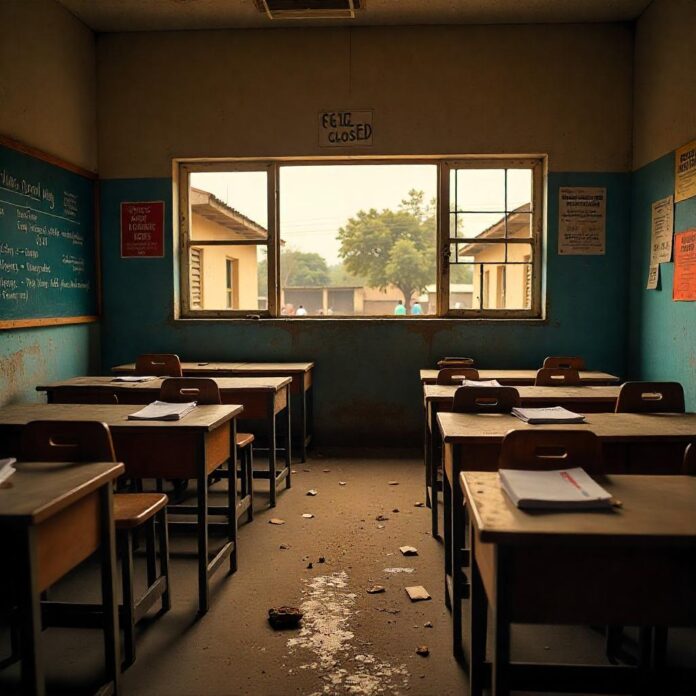The dust hadn’t settled from the March 7, 2024, Kuriga school attack when grieving parents realized 287 children—some as young as five—had vanished into Nigeria’s northwestern forests. This wasn’t an isolated tragedy but the latest hemorrhage in a decade-long crisis that has seen over 1,680 students kidnapped since Boko Haram’s 2014 Chibok abduction. By July 2025, the violence reached catastrophic levels: 2,266 Nigerians killed in just six months—more than all of 2024. Behind these numbers lie villages where children whisper about “forest monsters” instead of dreaming of classrooms, and parents bury homemade GPS trackers in their children’s clothing before school. This is the human reality of Northwest Nigeria’s banditry epidemic—a crisis metastasizing from localized crime to national catastrophe.
Historical Evolution: From Ideology to Profit
The 2014 Chibok kidnapping marked a grim turning point when 276 girls were seized by Boko Haram to wage ideological warfare against Western education. But by 2021, a seismic shift occurred. Ideology gave way to pure profit. Bandits—many former herders displaced by climate change and land conflicts—began systematizing abductions as revenue streams. The Kuriga attack typified this evolution: no political demands, just a ₦1 billion ($600,000) ransom ask. Today, an estimated 30,000+ bandits dominate ungoverned forests across Zamfara, Kaduna, and Katsina, exploiting gold mines and cattle rustling to fund arsenals rivaling state forces. Their business model? Human trafficking scaled into an industrial operation.
Anatomy of a Kidnapping: How Bandits Operate
Preparation and Surveillance
Bandits infiltrate communities through informants—disgruntled ex-students, compromised staff, or coerced villagers. Before the Kuriga raid, attackers spent weeks mapping escape routes through the Goron Dutse river valley and timing security patrols. Their firepower, sourced from Libya’s post-Gaddafi arms markets, includes RPGs and AK-47s—part of the 60,000+ illicit weapons flooding the Northwest.
Attack and Extraction
Dawn assaults are textbook. At Kuriga, 50+ motorcycle-riding gunmen surrounded the school from all angles, overwhelming unarmed teachers. Victims were herded like livestock into forests—a tactic enabling disappearances within hours. Security forces often arrive too late; in Kuriga, troops came several hours after the abduction, allowing bandits to reach deep forest strongholds.
Ransom Economy
Negotiations unfold via encrypted apps like Signal. Payments traverse hawala networks—informal transfers untraceable by authorities. This system fuels a multi-billion dollar ransom industry that dwarfs Nigeria’s education budget. When ransoms lag, bandits weaponize brutality: in 2025, a hostage’s sister was executed after a payment deadline passed.
Key Players: Bandit Warlords and Networks
The warlords governing these criminal enterprises have created parallel states. Bello Turji imposes “taxes” on Sokoto-Zamfara villages while coordinating mass kidnappings like the 2021 abduction of 150 students. Ansaru, linked to al-Qaeda, blends jihadist rhetoric with ransom profiteering and was implicated in the 2024 Kuriga kidnapping. Their networks stretch into Niger and Chad, using porous borders for arms smuggling and hostage trafficking.
Impact: Shattered Lives and Systems
Education Collapse
One in three Nigerian children is now out of school, with 66% of these children concentrated in the Northwest. After the Kuriga raid, 90% of students in Chikun district stopped attending classes—a generational time bomb. Only 37% of schools across ten Nigerian states have early warning systems to identify threats like school attacks, with Kaduna and Sokoto particularly vulnerable at 25-26% compliance.
Psychological Scars
“They beat us with sticks if we cried,” testified a Chibok survivor. Parents like Hassan Abdullahi, who lost 17 children to bandits, now bury empty coffins. The trauma extends beyond immediate victims, creating communities where chronic fear has replaced childhood normalcy.
Economic Devastation
Communities sell ancestral farmlands to pay ransoms. Foreign investors flee; in Kaduna, agribusiness projects collapsed by 40% after the 2024 abductions. The diversion of resources to ransom payments and security has crippled local economies, trapping communities in cycles of poverty that fuel further criminality.
Government Response: Gaps and Failures
President Tinubu’s 2023 “no ransom” pledge collapsed silently—Kuriga’s children were freed only after backchannel payments. Military efforts are hamstrung: troops fight Boko Haram, secessionists, and bandits across four fronts with aging weapons. In June 2025 alone, 17 soldiers died in Kaduna-Niger operations. The 2015 Safe Schools Initiative remains largely unimplemented, with rural schools like Kuriga lacking fences, guards, and emergency protocols—making them sitting ducks for predators.
Solutions: Pathways to Security
Immediate Actions
Forest sanitization operations show promise when coordinated properly, as demonstrated by July 2025’s Katsina operation where 30 bandits were killed during coordinated airstrikes. Community intelligence networks like Sokoto’s Saka Ida reduced kidnappings by 35% in 2024 through encrypted tip lines enabling real-time alerts.
Structural Reforms
Establishing state policing would enable officers who know local terrains and dialects—critical where federal forces are viewed as occupiers. Economic amnesty programs offering vocational training for surrendered bandits, mirroring Niger’s 2024 initiative that cut recruitment by 50%, could break the cycle of violence.
International Leverage
Drone surveillance along Nigeria-Niger border trails could monitor hostage movements. UNICEF’s psychosocial centers in Maiduguri demonstrate effective models for survivor rehabilitation that should be scaled across the Northwest.
The Crossroads
Ten years after Chibok, Nigeria’s children remain currency in a war fueled by corruption, poverty, and failed governance. As National Human Rights Commission head Tony Ojukwu implored, these victims were not mere statistics but extinguished futures. Yet flickers of hope persist: Zamfara’s community-policing trials cut bandit attacks by 65% in 2024. The path forward demands deploying every tool from drone technology to economic inclusion. Without addressing root causes—crushing poverty, youth unemployment, and governance failures—the forests will keep swallowing classrooms whole. As one Kuriga mother pleaded to Governor Uba Sani’s departing convoy: “Please stay and help us, don’t leave us.” Her cry echoes across a nation at a defining crossroads between perpetual violence and reclaiming its stolen future.


